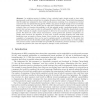Free Online Productivity Tools
i2Speak
i2Symbol
i2OCR
iTex2Img
iWeb2Print
iWeb2Shot
i2Type
iPdf2Split
iPdf2Merge
i2Bopomofo
i2Arabic
i2Style
i2Image
i2PDF
iLatex2Rtf
Sci2ools
115
Voted
NC
2008
2008
How crystals that sense and respond to their environments could evolve
An enduring mystery in biology is how a physical entity simple enough to have arisen spontaneously could have evolved into the complex life seen on Earth today. Cairns-Smith has proposed that life might have originated in clays which stored genomes consisting of an arrangement of crystal monomers that was replicated during growth. While a clay genome is simple enough to have conceivably arisen spontaneously, it is not obvious how it might have produced more complex forms as a result of evolution. Here, we examine this possibility in the tile assembly model, a generalized model of crystal growth that has been used to study the self-assembly of DNA tiles. We describe hypothetical crystals for which evolution of complex crystal sequences is driven by the scarceness of resources required for growth. We show how, under certain circumstances, crystal growth that performs computation can predict which resources are abundant. In such cases, crystals executing programs that make these predictio...
Complex | Crystals | NC 1998 | NC 2008 | Tile Assembly Model |
| Added | 14 Dec 2010 |
| Updated | 14 Dec 2010 |
| Type | Journal |
| Year | 2008 |
| Where | NC |
| Authors | Rebecca Schulman, Erik Winfree |
Comments (0)

